ikfoundation.org
The IK Foundation
Promoting Natural & Cultural History
Since 1988


 Crowdfunding Campaign
Crowdfunding Campaignkeep knowledge open, connected, and growing on this textile history resource...
A STUDY OF KNITTING SHEATHS
– from North Yorkshire
Whitby Museum keeps an interesting collection of some thirty sheaths. These aids to knitting were traditionally called “sheath”, only becoming known as “stick” or “needle support” during the 20th century. With only one exception, those in the collection are made of wood and all are 5 to 20cm long, most of them 10 to 15cm. This study aims to give a brief history of such practical as well as often beautifully carved implements. Various designs, the skills of professional and amateur carvers along with the everyday uses of knitting sheaths in the local area will also briefly be looked upon. Three photographs may present further thoughts on its practice in late 19th century Whitby.
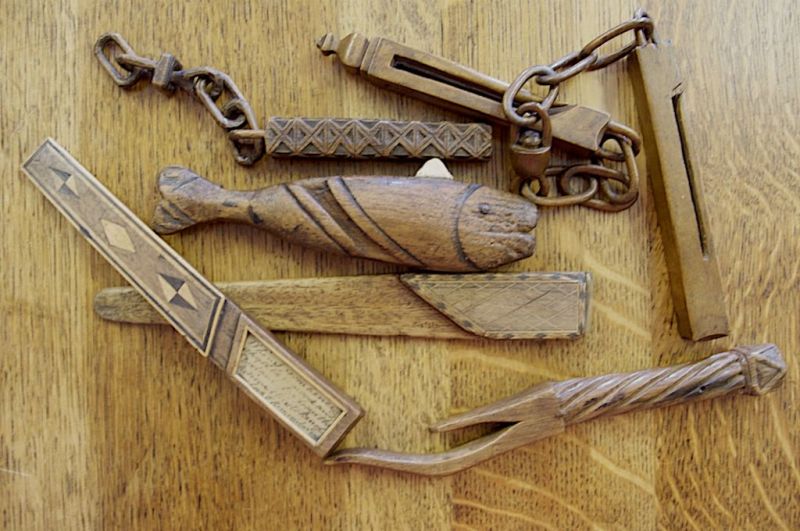 A selection of knitting sheaths – all in personalised designs (Whitby Museum, Social History Collection). Photo: Viveka Hansen.
A selection of knitting sheaths – all in personalised designs (Whitby Museum, Social History Collection). Photo: Viveka Hansen.Some sheaths are curved and others straight, many with a groove cut at the back so they more easily can be fastened to the belt or waist-band of the knitter’s skirt. At the other end is a hole into which a curved or straight needle may be fixed depending on the model, the hole being reinforced in some cases with leather or metal to reduce wear and tear. Any pattern is most often on the front, in the form of an inserted carved or turned motif in wood or a paper design behind glass. The back is usually smooth, apart from the initials that appear on some examples. Only two in the collection are dated – 1860 and 1903 – but it may be assumed that some go back at least as far as the early 19th century. This technique of knitting with the weight of the knitted product supported by a sheath to free the hands made it both faster and easier for the knitter, especially when standing or walking. The tradition seems likely to go back to knitting schools that started as far back as 1590 in York, among other places. It is not known when knitters in Whitby first used sheaths but they were probably already familiar there by the early 18th century.
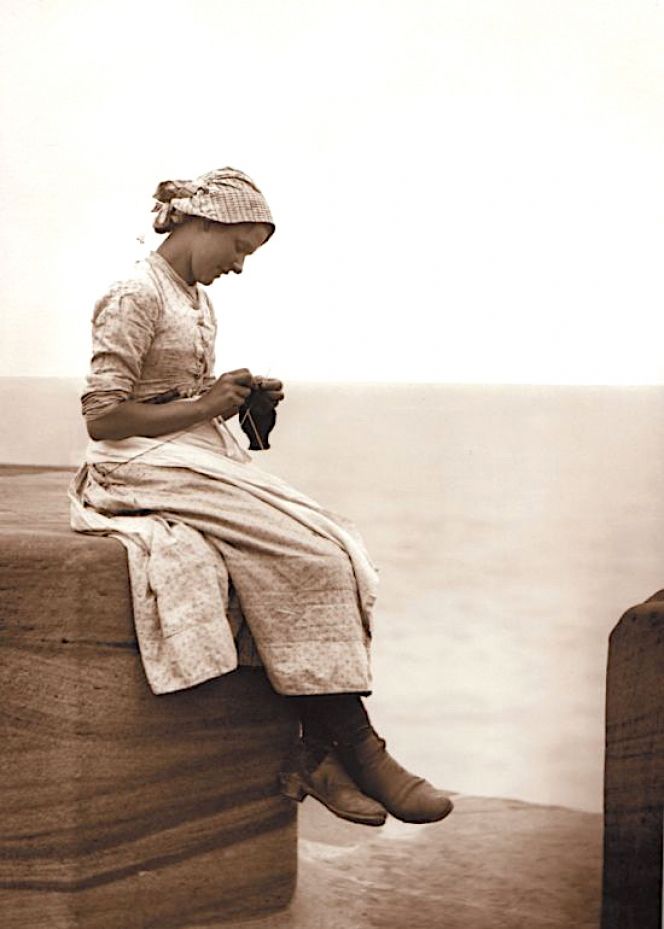 It is rare to get a glimpse of a knitting sheath in use, but this late 19th century photograph of a young woman on the West Pier in Whitby is an exception. The wooden aid seems to be fastened to the belt, visible just above her right arm. (Courtesy of: Whitby Museum, Photographic Collection. Photo: Frank Meadow Sutcliffe. B-2C).
It is rare to get a glimpse of a knitting sheath in use, but this late 19th century photograph of a young woman on the West Pier in Whitby is an exception. The wooden aid seems to be fastened to the belt, visible just above her right arm. (Courtesy of: Whitby Museum, Photographic Collection. Photo: Frank Meadow Sutcliffe. B-2C). A few of these sheaths have been particularly skilfully made and are clearly the work of professional cabinet-makers who inserted into them small intarsia rhombus inlays or hearts made from various kinds of wood. One example has a hand-written verse behind glass (SOH 480). This particular verse has religious implications, but others could be more romantic in intention. However, most of these sheaths were carved or turned by amateurs, either as engagement presents or perhaps as a means for farm workers, shepherds or fishermen to earn themselves a little extra money. The ornamentation is very varied but most of these sheaths were probably made in Whitby or within a radius of ten or twenty miles of the town. Some have been rounded smoothly on a lathe, without any groove to rest on the belt. Various native varieties of wood have been used in their manufacture, with a few of the most recent sheaths – one of them (SOH 527) dated 1903 – carved from a very light kind of wood and afterwards stained brown. Sometimes bone, horn or leather has been added. One highly unusual specimen, delicate but very heavy, has been formed entirely of brass, probably as an engagement present (SOH 86).
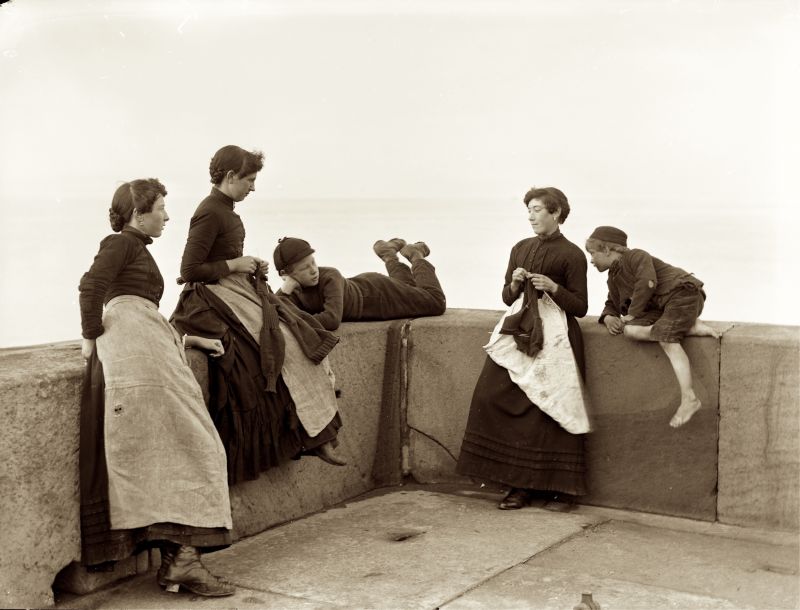 Frank Meadow Sutcliffe took several other photographs of standing or sitting local women and girls, but if sheaths were in use on these portraits, these were concealed by either clothing or arms of the knitting person (Courtesy of: Whitby Museum, Photographic Collection. Photo: Frank Meadow Sutcliffe. 20-45A).
Frank Meadow Sutcliffe took several other photographs of standing or sitting local women and girls, but if sheaths were in use on these portraits, these were concealed by either clothing or arms of the knitting person (Courtesy of: Whitby Museum, Photographic Collection. Photo: Frank Meadow Sutcliffe. 20-45A).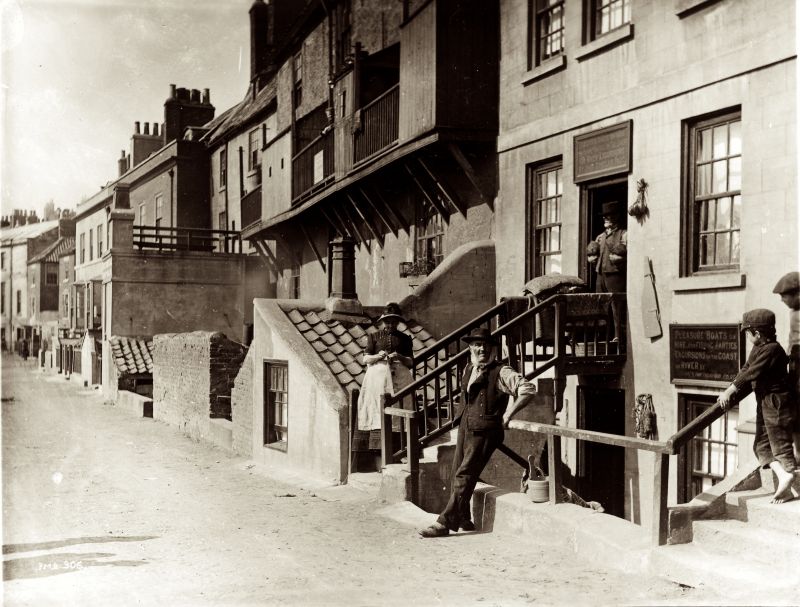 A woman knitting on Pier Road, Whitby. Knitting was an ideal occupation for filling spare moments, both indoors and out of doors. To knit stockings or other small garments were especially practical while standing or walking, but also in this picture the sheath (if in use) was not visible for the camera (Courtesy of: Whitby Museum Library & Archive, Photograph book two, 2/35. Unknown photographer).
A woman knitting on Pier Road, Whitby. Knitting was an ideal occupation for filling spare moments, both indoors and out of doors. To knit stockings or other small garments were especially practical while standing or walking, but also in this picture the sheath (if in use) was not visible for the camera (Courtesy of: Whitby Museum Library & Archive, Photograph book two, 2/35. Unknown photographer).The most elaborate variety is undoubtedly the ‘knitting sheath with chain’, always made as a single unit. The Whitby collection has several examples of this very complicated creation in wood; in one case complete with a wool-winding hook and pocket-knife and inscribed “M.W. 1860”, while another has been carved for “Eliza Kirby”. The most popular motifs for carving were hearts, leaves, rhombuses and simple geometrical shapes. Two of the more uncommon varieties are a flat sheath whose brass end has two holes in it and a polka-dot décor (SOH 80) and a sheath shaped like a fish with a piece of whalebone inserted as its dorsal fin (SOH 2000/4). See the images below. Common to all these sheaths is their individuality, so that one never finds two identical ones even if some clearly belong to the same general group or type. The Whitby collection is not extensive enough for exact classification; all we can be sure of is that these beautifully ornamented knitting sheaths were made according to the personal taste of each individual carpenter both from the aesthetic point of view as something beautiful to look at, and from the practical angle of the needs of the knitting woman.
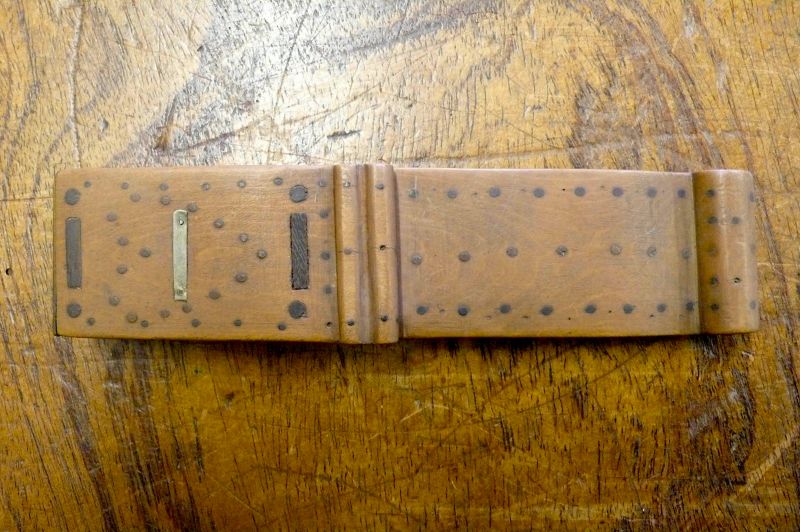 Knitting sheath in wood with brass end, polka-dot and heart shaped décor (Whitby Museum, Social History Collection SOH80). Photo: Viveka Hansen.
Knitting sheath in wood with brass end, polka-dot and heart shaped décor (Whitby Museum, Social History Collection SOH80). Photo: Viveka Hansen.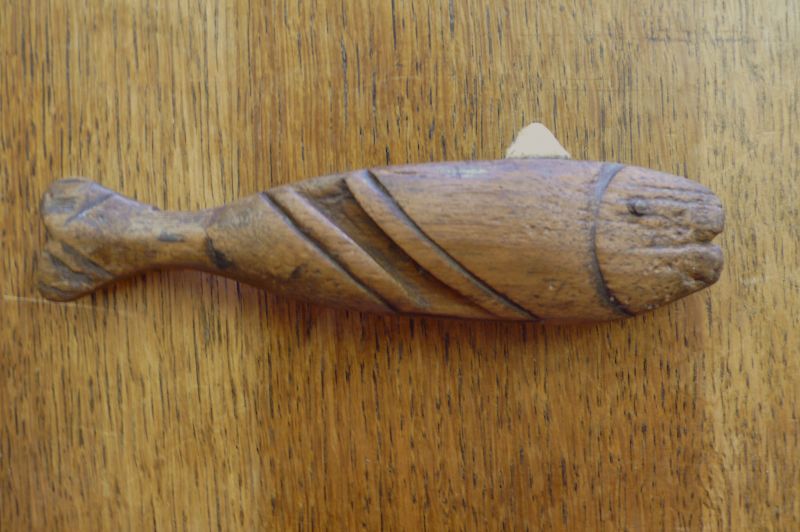 Fish-shaped knitting sheath, wood with a piece of whalebone (Whitby Museum, Social History Collection, SOH 2000/4). Photo: Viveka Hansen.
Fish-shaped knitting sheath, wood with a piece of whalebone (Whitby Museum, Social History Collection, SOH 2000/4). Photo: Viveka Hansen.Sources:
- Brears, Peter, North Country Folk Art, Edinburgh 1989.
- Hansen, Viveka, The Textile History of Whitby 1700-1914 – A lively coastal town between the North Sea and North York Moors, London & Whitby 2015 (pp. 273-85).
- Whitby Museum, Photographic Collection and Library & Archive (studies of local photographs).
- Whitby Museum, Social History Collection (knitting sheaths, some tools unnumbered at time of research).
More in Books & Art:
Essays
The iTEXTILIS is a division of The IK Workshop Society – a global and unique forum for all those interested in Natural & Cultural History.
Open Access Essays by Textile Historian Viveka Hansen
Textile historian Viveka Hansen offers a collection of open-access essays, published under Creative Commons licenses and freely available to all. These essays weave together her latest research, previously published monographs, and earlier projects dating back to the late 1980s. Some essays include rare archival material — originally published in other languages — now translated into English for the first time. These texts reveal little-known aspects of textile history, previously accessible mainly to audiences in Northern Europe. Hansen’s work spans a rich range of topics: the global textile trade, material culture, cloth manufacturing, fashion history, natural dyeing techniques, and the fascinating world of early travelling naturalists — notably the “Linnaean network” — all examined through a global historical lens.
Help secure the future of open access at iTEXTILIS essays! Your donation will keep knowledge open, connected, and growing on this textile history resource.
been copied to your clipboard




– a truly European organisation since 1988
Legal issues | Forget me | and much more...
You are welcome to use the information and knowledge from
The IK Workshop Society, as long as you follow a few simple rules.
LEARN MORE & I AGREE







